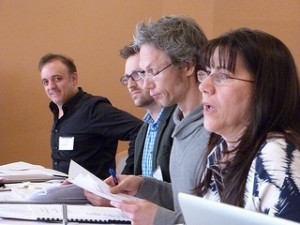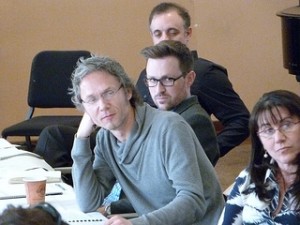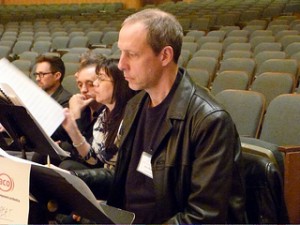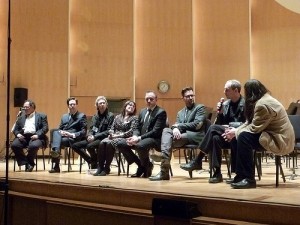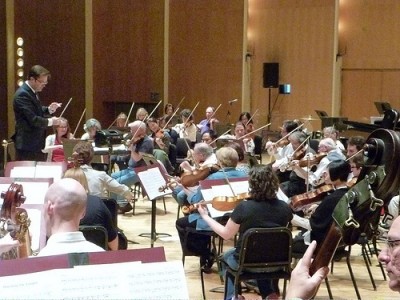Five jazz-associated composers took on the heady task of writing eight-minute works for full symphonic forces, introduced to the Buffalo Philharmonic Orchestra and worked up for performance by conductor Matt Kraemer on Tuesday and Wednesday this past week, thanks to Earshot /Jazz Composers Orchestra Initiative, organized by American Composers Orchestra.
As an “embedded journalist” (along with Frank J. Oteri, founder and editor of NewMusicBox.org) I observed the whole process closely, privy to private critiques and discussions composers Gregg August, Anita Brown, Joel Harrison, Ole Matheson and Dave Wilson had with Maestro Kraemer, instrumentalists from the Orchestra and mentoring composers Anthony Davis, Nicole Mitchell and James Newton. It was one of the most enlightening and intense of intensives I’ve experienced — much more so, I’m sure, for the composers whose ambitious, accomplished works were read.
Each of their pieces had distinct characters and challenges. These composers — August, a bassist in the conductorless Orpheus Chamber Ensemble, the Brooklyn Philharmonic and saxophonist JD Allen’s trio, among others;  Brown, leader of her own Jazz Orchestra, long involved with the BMI Jazz Composers Workshops and with ties to U.S. military music corps; Harrison, an electric guitarist and band leader who chafes at categorization, and has released 14 cds as a leader since 1995; Mathisen, a saxophonist who teaches at Columbia U., has composed for movies, tv and commercials, and — as I know him best — plays in the avant-garde Latin jazz SYOTOS ensemble; Wilson, a saxophonist in the ethnomusicology program at UCLA who’s worked with rock-pop stars and French gypsy jazzers — embraced this very rare opportunity of access to an orchestra to create genuinely new and unusual music.
To get their pieces across to the demanding and unjazzlike instrumentalist-interpreters, the composers had notated (most for the first time) in an infinitesimally coded and precise language, like hand-drawn hieroglypics for computer programming, to secure specificities of pitch, timing and tonality that would result in unique moment-after-moment of transformative sound.
I describe the pieces inadequately, I hope not inaccurately but surely insufficiently — because it’s impossible (for me at least) to completely hear, understand and absorb five such completely personalized projects of this scale on first impressions, quick go-overs of changes and one complete run-through. Though a recording made by the BPO of each culminating performance was made, I don’t have them to refer to; as per BPO/American Federation of Music union protocols and contracts, each is available only to its composer, and then degraded with spurts of white noise to protect against broadcast and/or pirate duplication. An un-marred three-minute excerpt will be made available to the composers for limited promotional uses.
- August’s “Una Rumba Sinfonia” was organized around a rhythmic motif  counter-intuitive to players steeped in Western classical tradition, which danced lightly but purposefully across instrument families with an elegant transparency;
- Brown’s”Disarming the Tempest” is a tone poem exploration of the interior experience of a Marine with post-traumatic stress disorder, asking the orchestra to employ unusual percussive sounds and include passages of pitched speech;
- Harrison’s “The Other River” seemed to me multiply episodic, with transitions like a dream which drifts through several moods then suddenly turns dramatic — in this case with a bold figure I took as an electric guitar line, though Joel initially thought of writing the piece as a bassoon concerto;
- Mathisen’s “Tone Poem: The Mind’s Eye Inverted” also moved laterally through several ideas, derived from his own tenor saxophone improvisations — both the music itself and the formal concept, his self-examination of his mental processes and group interactions while improvising. There was humor in this, maybe even merriment;
- Wilson’s “Springs of a Desperate Heart” was sensuous, evoking an unlikely combination of inspirations: the life and songs of Billie Holiday and Macedonian folk music and legends — which resulted in an exotic garden in which an oboe sang like a nightingale.
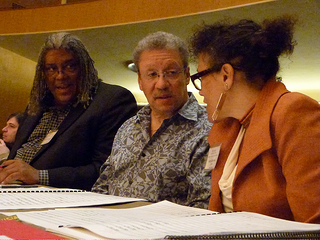
Mentors, from l., James Newton,
Anthony Davis, Nicole Mitchell
The amount of detail — and concentration — that goes into composing and performing new music for orchestra is astounding. Bill Holab, a specialist in music publishing (including copyright issues), held a workshop going into some depth about simply how to set up scores and parts for ease of reading. The composers (and some local composition students) were raptly attentive. How big should the paper be? What weight? How can long pieces be laid out to everyone’s advantage? These things matter.
I’ve had previous up-close experience watching the birth and development of compositions for chamber ensembles, but total immersion in the vast unto infinite strains and dimensions available from an orchestra of several dozen virtuosi able to deliver astute realizations of never-bef0re-seen parts almost instantly was a process
I’d never seen before, or tried to understand as a strictly auditory phenomenon, either.
My ears were stretched, without doubt, and my curiosity stirred about some of the larger questions accompanying this project. What can it mean for a jazz composer to write for the orchestra — when it’s so  unusual to get the chance to even hear such work performed? What will happen to these pieces, which I’d personally like to hear again, but know the odds are against them being placed with orchestras for further
performance? What about the jazz elements in these compositions: Are there any on an audible level, or do they mostly exist as foundational, and in the composers’ attitudes? How should the tradition-bound symphony orchestra open up its language and repertoire to jazz ideas? How can that best be effected? Do symphonies want to do it? What would the result be of a turnabout project suggested by Frank J. Oteri — What would happen is some symphony composers were enlisted to write for jazz big band or combo, in the jazz language?
Like every worthy experiment, this one raised more questions than answers, one of the most pressing being how can worthy experiments like the Jazz Composers Orchestra Initiative be assured of ongoing funding? Related: Who has a stake in being sure that jazz artists have all the opportunities (should they seek them) to partake of the enormous palette the traditional orchestra has come to perfect? How do the orchestra’s supporters feel about discovering and accepting new music? Is the cliché true, that all seasons’ series ticket buyers want is the beloved works of dead white European males?
Where do African-American composers — as were all the mentors composers, none of the “participating composers” — fit into this conception of jazz? And how about multi-kulti audiences? Â Does the “new music” world, largely comprising chamber music composers, ensembles and presenters who, of the current generation, have affinities for alt.rock, rap/hip-hop and pop, have any interest in bridging the jazz gap? How would listeners — those who identify themselves as symphony buffs or those who are jazz devotees — react to these compositions? Will they get a chance to hear them? Can the traditional symphony adapt to 21st century American and global musical diversity? What is the future of music? Who will write it? Who will play it? Who will listen to it? Who will love it?
* all photos thanks to Michael Geller and Greg Evans, American Composers Orchestra

